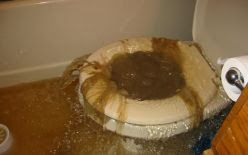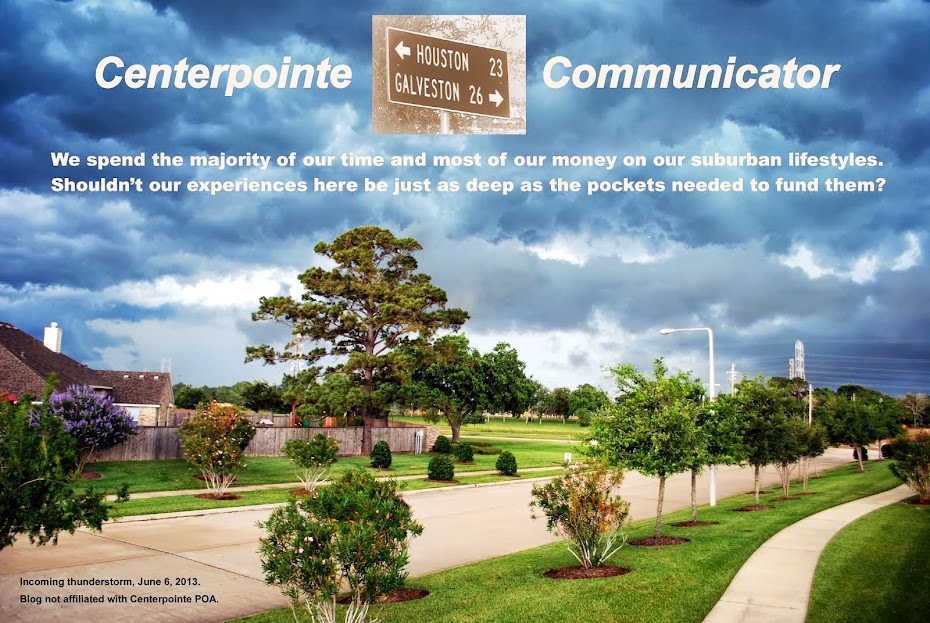Going back to the POA email blast from August 31, and following up on
my initial post of September 5, I'm going to expound on the advisory issued by the POA regarding our subdivision sewage system.
That may not seem like a very delectable blog topic to you, but in the event of a sewage system failure,
trust me - you are going to become
really interested in how it functions,
really quickly. In fact, at any such future point where you've been forced to live without a toilet for X amount of time, it would become
your ONLY topic of concern (lack of a/c would be a distant second).
Before I start, remember, I am
not an engineer and I am
not a POA member and this blog is
not an instrument of the POA. But I can take the POA's information and attempt to translate it using pictures so that it's easier for non-technical residents to understand, which is what I'm going to do here. Because when people understand underlying issues, they tend to make more appropriate behavioral decisions.
So let's start with what was emailed on August 31, emphasis mine:
Also good to note is that in the event of power loss - our sewer/waste lift/pump station will not pump waste out of the sewer lines. Thus as I mentioned above- the [sewage] that was flowing to the lift station will now flow back to Cypress/White Oak Pointes. If we [lose] power for any extended amount of time - residents are urged not only by the city and county to fill your bathtubs for cooking needs and refrain from flushing your toilets until instructed to do so, but I would think that all neighbors EAST of Lilac Pointe would insist on it!
OK, it doesn't get more ominous-sounding than that, but what the heck does it all mean?!
SHORT VERSION: We're all in this subdivision thing together. If you receive a text or email blast instructing you not to generate wastewater during any particular emergency situation, take it
very seriously because they're not kidding. Even if we still have good water pressure, we might not have sewage transfer capability, because the two are not directly related. Don't assume that just because we have one, we also have the other.
LONG VERSION: In order to begin understanding sewage management, all you need to do is remember that immortal adage,
"Sh*t rolls downhill." That's what's happening from each of your houses and the rest of what happens is mostly a consequence of that.
Let's start from the very beginning, because many residents didn't witness the construction of their own houses, and of those who did, many didn't understand what they were seeing.
 |
| Inside your slab are numerous PVC lines which connect your sinks, showers, and toilets to the sewer service line which leads from your house. This is a picture of an early phase of construction where the lines have been laid but the concrete slab is not yet poured. The tradesmen put temporary caps on all the lines so that they could test for water-tightness and also so that no soil would get accidentally pushed into the open ends. |
 |
| Somebody correct me if I'm wrong, but I suspect that all adjacent pairs of houses share sewer clean-out lines in Centerpointe, rather than each house having its own clean-out. The sewer clean-out is that baby blue pipe in the center (that particular one got busted by a backhoe and had to be replaced before this area was backfilled). You can see white lines leading from each house and converging where this vertical pipe is situated. |
 |
| This is what the finished, capped sewer clean-out line looks like in your front yard. Many people paint them brown or green so that they will be less noticeable. |
 |
And this is a simplified diagram showing the corresponding line arrangement. In this example, the house has a basement, so the clean-out is situated in the basement rather than in its front yard.
Notice that the sewer service line from the house connects to a sewer main under the street. That "sewer main" is actually a "gravity sewer". It is sloped to drain passively toward a piece of wastewater management infrastructure called a "lift station".
In other words, stuff really does roll downhill. There is no mechanical apparatus that pumps sewage away from your home. It simply follows the engineered slope downward. And if there's a slope, there must be a lowest point somewhere in the general equation. That point would be the lift station. |
 |
This is not a diagram of Centerpointe - I don't have one specific to our subdivision. But this is an example of a residential area where you can see gravity sewers in green, and they are engineered to drain toward a lift station.
To my knowledge, Centerpointe has only one lift station. It looks like this: |
 |
It's near Centerpointe Drive and the eastern Boxelder cul-de-sac. There's not much to see above ground because the guts of it are in a deep shaft.
Screengrabbed from Googlemaps. |
 |
This is approximately what the inside of the deep shaft looks like. All of those gravity sewers feed into mains which, in turn, feed into a deep concrete-lined hole like this. It has to be deep because Centerpointe is about one mile across. Obviously if individual sewer mains are gravity-draining by virtue of their slopes, by the time they get all the way from (for instance) Azalea Pointe near Calder to the lift station, their slope trajectories have put them far underground.
But a deep line is not necessary to convey all that collected waste material to the League City wastewater treatment plant, and deep lines are expensive to construct, so at that point, the waste is "lifted" by a pump back up to what's called a "force main" which is situated at a shallower depth (the white pipe exiting to the right in the diagram above). The flow in a force main is via mechanical transfer, thus the word "force" to distinguish it from "gravity". The sewage travels in the force main to its eventual destination which is the treatment plant. |
So now you can start to visualize what the POA was talking about regarding the issue of a possible power failure due to hurricane or whatever. The wastewater from 438 homes collects in this lift station. If there's no power to run the pump that is necessary for it to continue on its way, that deep shaft might entirely fill up with untreated sewage. If the level rises too high, it will start
back-flowing up the gravity mains, because it has to go
somewhere. And if it completely fills any given gravity main, then it's got no choice but to back up into individual service lines. And then this might happen:
 |
Scenes like this are rare but absolutely devastating, obviously. This is backed-up sewage spewing forth from a commode. When stuff is blocked from rolling downhill, it will enthusiastically start rolling uphill.
The reason why it's so actively flowing in this example is probably because other users in the system are still trying to add wastewater to the gravity sewer system, not realizing that it can no longer physically accept any more wastewater.
Screengrabbed from this source. |
If I'm understanding correctly, the POA was calling attention to the fact that some areas of Centerpointe are lower in relative elevation than other areas. So some areas might be more susceptible to the consequences of a system failure. If I'm understanding correctly, this is what prompted the comment
"...refrain from flushing your toilets until instructed to do so, but I would think that all neighbors EAST of Lilac Pointe would insist on it."
From this, I interpret that people east of Lilac Pointe might be more at risk of getting the proverbial
sh*tty end of the stick in more than just the
idiomatic sense.
There are two pieces of good news in all of this:
- Toilets ejecting raw sewage upward with a force exceeding 1G are not, I repeat NOT, in the interest of public health, and governments know it. Recent hurricanes including Ike and Dolly five years ago underscored the need for emergency generators to supply power at lift stations, after stories like this one became common (here's another reference). These days, wastewater operators need to keep emergency generators on hand for the duration of hurricane season in order to prevent exactly that type of septic scenario depicted above. I don't know how those rules affect League City, but I assume that the city is subject to some requirements of this type. This is good news but it is also a contingency we can't absolutely rely on. Emergency generators need fuel, and we know what happened to the fuel supply chain during Hurricane Rita (for those of you who weren't here, it collapsed).
- Yesterday was SciGuy Day, the September calendar date after which the chances of a hurricane become very low for the upper Texas coast. Hurricane season doesn't officially end until November 30, but prevailing autumn weather patterns tend to be very protective of our area after September 24 (that's certainly the date after which I begin re-stocking my mega-freezer, which we "eat down" over the summer in case we get a hurricane that kills electricity and thus ruins its very expensive home-made organic contents). So if there ever comes a point where I need to refer you back to this post so that you can review why you shouldn't flush your commode, it almost certainly won't be until a future year (whew!).
 |
Until that day, happy flushing!!
Screengrabbed from this source. |
I can't seem to embed this, but here's
a link to this video from KPRC and a screengrab from it below
if you'd like more info on the significance of the September 24 date.




















































